
Friday September 21,
2007.
The focus of the New Pinakothek art
museum in Munich, Germany is European Art
of the 18th and 19th century. It is one
of the most important museums of art of
the 19th century in the world. The museum
was founded by the former King Ludwig I
of Bavaria in 1853. Ludwig began to
collect contemporary art already as crown
prince in 1809 and his collection has
been steadily enlarged. In 1853 the works
held in the existing collection was split
between the New Pinakothek and the Alte
Pinakothek. Art works of the so-called
old masters were placed in the Alte
Pinakothek while art from the period
shortly before the turn of the 19th
century was gathered in the New
Pinakothek. This delineation has become
the prototype for many other galleries.
|
|
|
The original Neue Pinakothek was destroyed
during World War II. I believe the artwork
had been removed to protect it. Between 1976 and 1981
the Neue Pinakothek was rebuilt as you see it now.
|
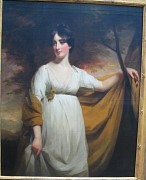
Henry Raeburn (1756-1823)
Mrs. John Campbell of Kilberry 1802
Of course, I am no art
critic, and don't presume to understand
enough about the subject to be one. During
the Napoleonic era, is this an accurate
representation of how (rich) women looked? I
like the placing of the hands, one looped
over a branch and the other gently bunching a bit
of dress. I believe this could be called a
milky complexion. I think outdoor gardens
were popular, which may be why nature is so
predominately featured.
|
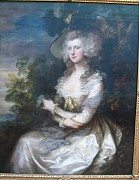
Thomas Gainsborough (1727-1788)
Mrs Thomas Hibbert 1786
It has been said that,
"... Mrs Thomas Hibbert, Gainsborough painted
more from his observations of nature (and human
nature) than from any application of formal
academic rules."
This portrait is a
generation earlier than the portrait just
above. Although there is something
unrealistic about the facial features, I like
the elaborate dress, hair, and hat. Again,
the hands are doing something other being
folded in front - perhaps very early in the
portrait business artists got bored of folded
hands.
|
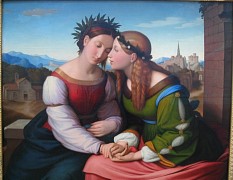
Friedrich Overbeck (1789-1869)
Italia and Germania 1828
Overbeck and his
confederates became known among friends and
enemies by the descriptive epithet "The
Nazarenes". The characteristics of the style
thus educed were nobility of idea, precision
and even hardness of outline, scholastic
composition, with the addition of light, shade
and color. The theme of this painting is that
Italy and Germany should be as close as
sisters. One notes the layout of many ancient
Bavarian towns follow the model of Italian
towns.
|
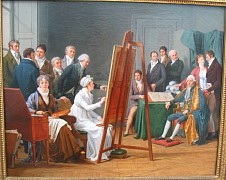
Marie-Gabrielle Capet (1761-1818)
Studio Scene 1808
Marie-Gabrielle Capet
studied under the famous woman painter of her
day, Labille-Guiard, and was her most
accomplished disciple in the art of miniature
portrait painting. After the French Revolution,
the public exhibitions of the Salons were
opened to women and Capet exhibited works
numerous times in these displays. I find making
a painting of the behind the scene look at
making a painting interesting. To quote the
Monty Python skit, "So who's painting us now?"
|
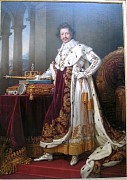
Joseph Stieler (1781-1858)
King Ludwig I in Coronation Robes 1826
Here is the man who began
the art collection that eventually found it's
way into the New Pinakothek. Son of King
Maximilian I and Wilhelmine of
Hessen-Darmstadt, Ludwig married Therese of
Saxe-Hildburghausen in October, 1810. The
wedding was the basis for the popular
Oktoberfest celebration. Stieler worked mainly
in the service of the Bavarian court. His
painted likenesses in Schloss Nymphenburg,
Schö®¨¥itengalerie, the so-called Gallery of
Beauties, were commissioned by King Ludwig
I.
Ludwig was a benefactor
of the arts, and under his reign, Munich
became a cultural center of Germany. Ludwig
brought composers, poets, and writers to
Munich, as well as scientists and
architects.
|
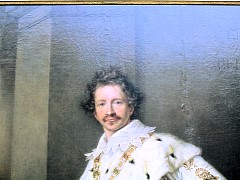 Ludwig I
was king of Bavaria from 1825 until his forced
abdication in 1848, following a scandal with
his mistress, Lola Montez, who was one of women
in the Gallery of Beauties.
Ludwig I's downfall When Ludwid came to the
throne of Bavaria in 1825, most of his
political policies were quite liberal. As time
progressed, however, he began to impose
censorship and high taxes upon his subjects.
The Revolution of 1848 imposed new restrictions
on the office of the king, and forced Ludwig to
abdicate. Ludwig tried several unsuccessful
attempts to leave Bavaria and live in exile
with Lola. Ludwig died in 1868, at the age of
81. For the last twenty years he wandered his
estates alone, nearly deaf, no longer King of
Bavaria. Ludwig I
was king of Bavaria from 1825 until his forced
abdication in 1848, following a scandal with
his mistress, Lola Montez, who was one of women
in the Gallery of Beauties.
Ludwig I's downfall When Ludwid came to the
throne of Bavaria in 1825, most of his
political policies were quite liberal. As time
progressed, however, he began to impose
censorship and high taxes upon his subjects.
The Revolution of 1848 imposed new restrictions
on the office of the king, and forced Ludwig to
abdicate. Ludwig tried several unsuccessful
attempts to leave Bavaria and live in exile
with Lola. Ludwig died in 1868, at the age of
81. For the last twenty years he wandered his
estates alone, nearly deaf, no longer King of
Bavaria.
|
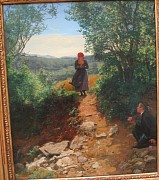
Ferdinand Georg Waldmüller (1793-1865)
The Expected One 1860
Waldmüller later became
interested in nature and thus started painting
landscapes. His most notable
work lies in the depiction of nature, where his
sense for colors and large knowledge of nature
helped him to achieve masterly skills. It seems
to me the depiction of nature in this picture
reaches almost the same level of detail that
you would find in a photo. What makes the photo
is the chaste appearance of the young woman and
the eager, joyous body language of the young
man. When the society was more agrarian I
suppose many more meetings of young lovers
would take place out away from prying
eyes.
|
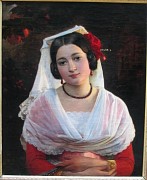
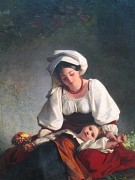
August Riedel (1799-1883)
Felice Berardi from Albano 1842 (l)
A Mother from Alvito 1848 (r)
Riedel, who is also known
for his psychologically sensitive portraits, is
primarily appreciated for his Italian genre
scenes, which, early on, displayed a
characteristically heightened and luminous
coloration.
|
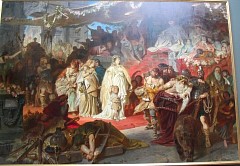
Carl Theodor von Piloty (1824-1886)
Thusnelda Led in Germanicus' Triumph 1873/74
Karl Theodor von Piloty
became famous for his large-format history
paintings showing emotional scenes. Here
captive and pregnant Thusnelda, wife of the
Arminius who led a coalition of Germanic tribes
to victory over the romans in the Battle of the
Teutoburg Forest, is led in front of Emperor
during the roman triumph of Germanicus, the
nephew of Tiberius. Her young son Thumelicus
would be trained at the gladiator school in
Ravenna and is believed to have died in a
gladiator show at a fairly young age.
|
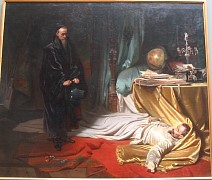
Seni at the Dead Body of Wallenstein 1855
Wallenstein was a
Catholic Bohemian soldier and politician who
gave his services (an army of 30,000 to 100,000
men) during the Danish Period of the Thirty
Years' War to the Holy Roman Emperor Ferdinand
II for no charge except the right to plunder
the territories that he conquered. The emperor
turned against him and Wallenstein, realizing
the extent of his danger, hoped to switch
sides. Certain senior Scottish and Irish
officers in his force killed him, probably at
the orders of the emperor. Notice in the
painting how Wallenstein is bathed in
light.
|
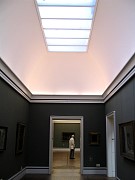
Me (1957-?)
Anonymous Man and Rectangles in the New Pinakothek 2007
A plethora of rectangles
encompass this anonymous man inside the New
Pinakothek. The museum was not crowded at all,
which added to the viewing enjoyment.
Glass roofs allow the rooms to be illuminated by
natural light.
|
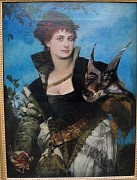
Hans Makart (1840-1884)
The Falconer c. 1880
Makart is considered by
many as being the first art star, referred to
by contemporaries an "artist prince", but his
reputation diminished after his death in 1884.
Unfortunately Makart was in the habit of using
pigments and mediums that caused the vast
majority of his large paintings to practically
perish. The blues have turned into green; the
thickly applied paint has cracked and in some
instances crumbled away. This painting seems no
worse for wear. What caught my eye was the eyes
of women in the painting. I find something
quite appealing about them.
|
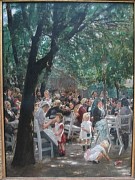
Max Liebermann (1847-1935)
Munich Beer Garden 1884
I like this painting for
a personal reason. On a weeknight in the summer
of 2003 we sat in a Munich beer garden on a
very hot summer night. The beer garden was a
large public park with lots of mature trees to
shade it. It got to be late at night, but while
most people certainly had work in the morning,
the beer garden remained packed.
|
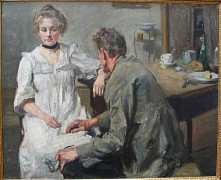
Max Slevogt (1868-1932)
The Day's Work Done 1900
Every husband understands
this picture.
|
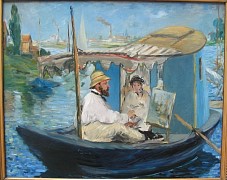
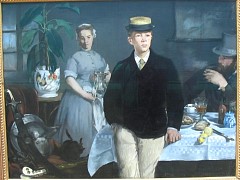
Edouard Manet (1832-1883)
Monet Painting on His Studio Boat 1874
Luncheon in the Studio 1868
My cousin the art teacher
says the painting Luncheon in the Studio is
about Manet's illegitimate son, who is the
young man in the picture. None of the people in
the painting are looking at each other, the boy
is oblivious to the fact that Manet is his
father. The woman is the mother.
|
|
From beggars to
prostitutes to the bourgeoisie Monet sought
to be true to himself and to reproduce "not
great art, but sincere art." Manet was not a
radical artist, such as Courbet; nor was he a
bohemian, as the critics had thought. The
well mannered and well bred Manet was an
immaculately groomed member of high society.
But Manet's unique technical innovations
intrigued the likes of Pierre Renoir and
Claude Monet and set free the traditional and
conservative reigns of academic
painting.
By 1874 Manet's
reputation as experimental artist and leader
of the Impressionists was firmly established.
The Cafe Guerbois, near Manet's studio became
the gathering spot for Monet, Renoir, Sisley,
Degas and Pissaro and although Manet presided
over the regular meeting and debates held at
the cafe, he was not enthusiastic about his
role as leader of the avant-garde. In 1874,
when the Impressionists held their first
exhibition at Nadar's studio, Manet refused
to participate. He chose instead to remain
focused on the Salon. He never exhibited in
any of the eight Impressionist exhibitions
and yet by no means did Manet abandon the
Impressionists. He worked closely with Monet
in Argenteuil during 1874 and often gave
financial support to his friends who needed
it. It was during this time that Manet came
closest to painting in the Impressionist
style. The painting Monet's Boat Studio
(above) approaches the notion and atmosphere
of Impressionism, but Manet never becomes
assimilated into the true Impressionist
style.
|
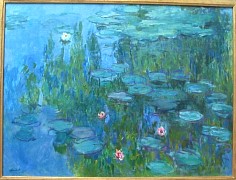
Claude Monet (1840-1926)
Water-Lilies c. 1915
Monet is considered the founder of
the impressionistic painting mode and himself
took part in 1874 in the first independent
exhibition of Impressionism in Paris with his
painting "Impression, soleil levant"
("Impression, sunrise") - whose title was to
lend its name to an entire art epoch.
Impressionism is characterized by concentration
on the immediate visual impression produced by
a scene and by the use of unmixed primary
colors and small strokes to simulate actual
reflected light.
|
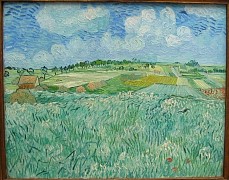
Vincent van Gogh (1853-1890)
Plain near Auvers 1890
Van
Gogh spent his early adult life working for a
firm of art dealers. After a brief spell as a
teacher, he became a missionary worker in a
very poor mining region. He did not embark upon
a career as an artist until 1880. His choice of
squalid living conditions did not endear him to
the appalled church authorities, who dismissed
him for "undermining the dignity of the
priesthood."
|
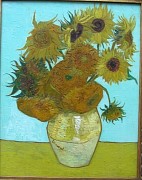
Vase with Twelve Sunflowers 1888
He began to paint
sunflowers to decorate a bedroom for his friend
Paul Gauguin. The series of sunflower paintings
was made possible by the innovations in
manufactured pigments in the 19th Century.
Without the vibrancy of the new colors, such as
chrome yellow, Van Gogh may never have achieved
the intensity of Sunflowers. These sunflowers
hold at their heart a simple parable about the
brevity of life; they are at varying stages in
the life cycle, from withered and wilting to
vibrant full bloom. Initially, van Gogh worked
only with sombre colors, until he encountered
Impressionism and Neo-Impressionism in Paris.
He incorporated their brighter colors and style
of painting into a uniquely recognizable style,
which was fully developed during the time he
spent at Arles, France. He produced more than
2,000 works, including around 900 paintings and
1,100 drawings and sketches, during the last
ten years of his life.
|
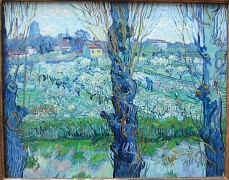
View of Arles 1889
Most of his best-known
works were produced in the final two years of
his life, during which time he cut off part of
his left ear following a breakdown in his
friendship with Paul Gauguin. After this he
suffered recurrent bouts of mental illness,
which led to his suicide.
|
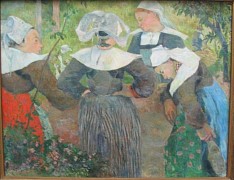
Paul Gauguin (1848-1903)
Four Breton Women 1886
In this picture Gauguin's
style has moved away from Impressionism
(although not completely). The picture was
created using sketches he made while living in
Brittany. My take on this choice of subject is
simple innocence.
|
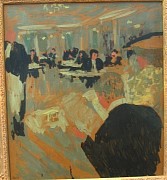
Edouard Vuillard (1868-1940)
Café Scene 1899
Vuillard was best known
for intimate, indoor looks at the private lives
of his subjects. Vuillard was part of an
artistic group called the Nabis, a word from
Hebrew and Arabic that means "prophet." Unlike
the Impressionists, who sought to capture the
fleeting effects of light in the outdoors, the
Nabis used art to communicate interior feelings
and to convey emotion.
|
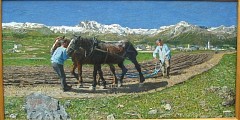
Giovanni Segantini (1858-1899)
Ploughing 1890
Segantini is known as the
painter of the Alps. I liked this particular
painting because of the background and because
it shows the interaction of man and beast while
ploughing - who in the modern age has ever seen
this activity?
|
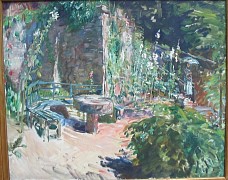
Max Sievogt (1868-1932)
Sunny Corner of a Garden 1921
I like the woman with the umbrella
standing off to the right garden - I think the artist made
her blend in with the tall plants leaving her hidden for
us to discover.
|
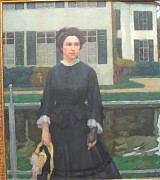
Leo Putz (1869-1940)
Frieda with Florentine Hat 1909
I liked this because it
depicts dress of the early twentieth century,
and the subject has and odd, tight-lipped
expression. In keeping with the portraits at
the top of this web page, note the artist has
something going on with each of the subject's
hands - one holds a hat while the other has
some lace covering the back.
|
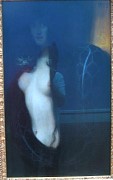
Franz von Stuck (1863-1928)
The Sin 1893
Stuck's subject matter
was primarily drawn from mythology. Large, heavy forms
dominate most of his paintings and point toward
his proclivities for sculpture. His seductive
female nudes, in the role of the femme fatale,
are a prime example of popular Symbolist
content. At his funeral address he
was memorialized as "the last prince of art of
Munich's great days".
As for this painting, I am drawn more
to the odd-reflective composition, not (just?)
the female nudity. I think it is of the modern era
and should be in The Modern Art Gallery, not here.
|